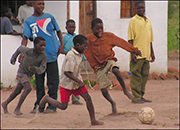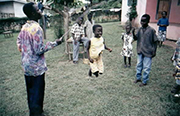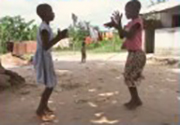Resource 3: Using games and physical exercise
![]() Background information / subject knowledge for teacher
Background information / subject knowledge for teacher
Physical exercise serves many functions. As we know, it helps children build up their strength and fitness. But it can also help pupils to develop social, creative and leadership skills. It can help pupils make friends and learn new things, and it contributes to their emotional well-being.
Think about the range of different physical games and exercises there are:
|  Original source: http://newsimg.bbc.co.uk (Accessed 2008) Original source: http://newsimg.bbc.co.uk (Accessed 2008) |
|  Original source: http://www.mindspring.com (Accessed 2008) Original source: http://www.mindspring.com (Accessed 2008) |
|  Original source: http://www.umanitoba.ca (Accessed 2008) Original source: http://www.umanitoba.ca (Accessed 2008) |
Children will automatically invent and play games with each other and you can exploit this as part of your teaching.
The use of physical games and exercises as part of your teaching can encourage pupils to enjoy learning, and so develop a greater interest in coming to school.
By using physical games as part of your teaching, you will also encourage pupils to acquire different talents, skills and behaviour patterns as they participate.
These can include:
- collaborative learning;
- thinking skills;
- sharing resources and taking turns;
- motivation and involvement in learning.
All of these are attributes you should encourage in the classroom, as they will contribute to more effective learning.
Below you will find some examples of Ghanaian games that use physical exercise.
| AMPE |
|---|
Objective: To be the highest scoring team. Equipment: Fast-paced music playing or clapping. Rules: Pupils divide into two teams. One player from one team stands opposite one player from the other team. One of these players is Ohyiwa and the other is Oware. Players begin jumping and clapping with the music. As they land, each manipulates one leg forward, with knee locked. Ohyiwa wins a point if his/her left leg meets the other player’s right leg or if his/her right leg meets the other player’s left leg. Oware wins if his/her left leg meets the other player’s left leg, or if their right legs meet. The team that reaches 10 points first wins. A set of games can be played and the team with the highest number of wins, wins the day. Adapted from: http://www.gameskidsplay.net (Accessed 2008) |
| PILOLO |
|---|
Objective: To find the hidden objects and get back to the finish line as quickly as possible. Equipment: Small balls, sticks, or pinnies. Rules: Select a leader. While the players close their eyes, the leader hides the objects all around the playing area (this may be best played outdoors or in large area with good hiding places). The players gather at a start/finish line. The leader then yells, ‘Pilolo!’ and the players run to find a hidden object and get back to the finish line first. The person who crosses the line first wins. The game is played several times. Adapted from: http://www.estcomp.ro (Accessed 2008) |
Resource 2: Planning ways to introduce the four principles of physical development



